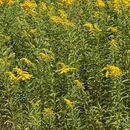Comments
provided by eFloras
Solidago canadensis is cultivated and introduced in more western states and in Europe. Very narrow limits for the species are followed here. Alternatively, the species has been defined broadly to include most other species of the subsection (e.g., A. Cronquist 1994).
Solidago ×bartramiana Fernald [S. canadensis var. bartramiana (Fernald) Beaudry] is considered to be a hybrid between S. canadensis and S. uliginosa. Its growth form and array are more like those of the latter.
Two sometimes difficult-to-distinguish varieties with greatly overlapping ranges are recognized.
- license
- cc-by-nc-sa-3.0
- copyright
- Missouri Botanical Garden, 4344 Shaw Boulevard, St. Louis, MO, 63110 USA
Description
provided by eFloras
Plants 30–150(–200) cm; rhizomes short to long creeping. Stems 1–20+, erect, glabrate proximally or sparsely strigoso-villous, becoming more densely so distal to mid stem. Leaves: basal 0; proximal to mid cauline usually withering by flowering, tapering to sessile bases, blades narrowly ovate-lanceolate, 50–190 × 5–30 mm, margins sharply serrate, 3-nerved, apices acuminate, abaxial faces glabrous or more commonly hairy along main nerves, adaxial glabrous or slightly scabrous; mid to distal similar, 30–50(–120) × 8–12 mm, largest near mid stem, reduced distally, margins usually serrate or serrulate (teeth 3–8), sometimes entire proximal to arrays. Heads (70–)150–1300+ , secund, in secund pyramidal-paniculiform arrays (obscurely so and club-shaped thyrsiform in small plants or shoots with small arrays), branches divergent and recurved, branches and peduncles hairy. Peduncles 3–3.4 mm, bracteoles 0–3, linear-triangular. Involucres narrowly campanulate, 1.7–2.5(–3) mm. Phyllaries in 3–4 series, strongly unequal, acute to obtuse; outer lanceolate, inner linear-lanceolate. Ray florets (5–)8–14(–18); laminae 0.5–1.5 × 0.15–0.3(–0.5) mm. Disc florets (2–)3–6(–8); corollas 2.2–2.8(–3) mm, lobes 0.4–0.8(–1) mm. Cypselae (narrowly obconic) 1–1.5 mm (ribbed), sparsely strigose; pappi 1.8–2.2 mm.
- license
- cc-by-nc-sa-3.0
- copyright
- Missouri Botanical Garden, 4344 Shaw Boulevard, St. Louis, MO, 63110 USA
Synonym
provided by eFloras
Aster canadensis (Linnaeus) Kuntze
- license
- cc-by-nc-sa-3.0
- copyright
- Missouri Botanical Garden, 4344 Shaw Boulevard, St. Louis, MO, 63110 USA

